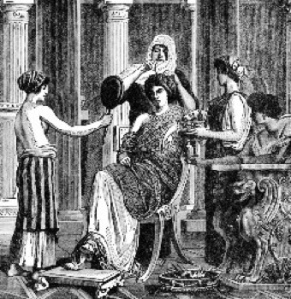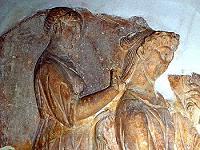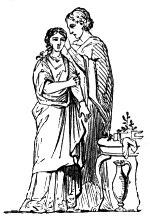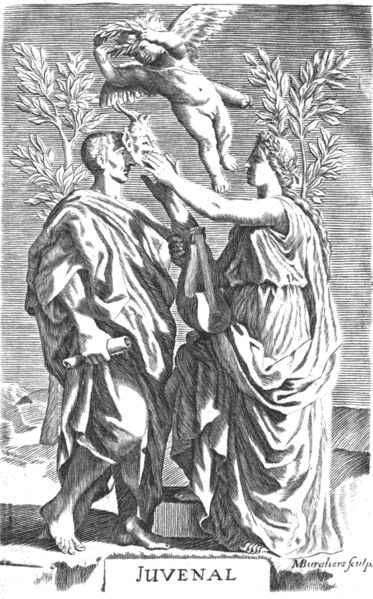 |
| Ancient Roman Ornatrix |
In ancient Rome, just as in the ancient civilisation of Mesopotamia,
baths and bodycare were an essential component of daily life. Sanitation
was important enough for rulers to install public toilets and sewers,
in order to avoid dirtiness in the streets and the spread of disease.
Both the number and variety of beauty and hygiene-related professions
flourished, predecessors to today’s hair stylists and make up artists in
salons and spas. Rich, noble families and Senators had the means to
hire personal barbers who lived with them in the decadent private villas
of Rome and worked directly with their clients on a daily basis, or as
often as required. Female stylists were kept busy, with the sole purpose
of caring for the lady of the household, without any break or time to
care for themselves. These domestic beauticians, called Ornatrix in
Latin, also took care of the household and bathrooms, and created hair
arrangements with the help of copper-based mirrors, primitive combs and
fibulae brooches.
 |
| Ornatrix statue in the Carthage Museum, Tunisia |
Far from being a privilege reserved for the few wealthy classes, many
more Romans sought their grooming in public barbershops, either inside a
dedicated building or out on the street corner. These workers
distinguished themselves with specially designed haircut gowns. They
were mostly preoccupied by the care of men, whose beards required weekly
attention. Aside from the basic format of the service, the functional
aspects of aesthetic care were important. Often, only a single seat was
available in the neighbourhood Botteca Tonsor, or barber shop. This gave
the client the hair dresser’s full, undivided attention during
sessions. Early versions of mirrors, different sizes of scissors,
statues and paintings on the walls provided the client with ideas of
styles from which to choose. For the customer’s comfort, more luxurious
shops provided towels or protective cape-like covers, called Involucrum,
but this was a relatively uncommon practice.
 |
| Ornatrix from Pompei |
In addition to the simple purpose of hair salon, the Tonsor also
operated as it still does today in many countries of the Middle East and
Asia, as a sort of general physician/practician, herbalist,
nutritionist, psychologist and private consultant. Even today, as in
ancient Rome, the barber was responsible for taking care of a variety of
important rituals that marked the milestones of a person’s life. These
ranged from “shaving the first offering to the gods” (circumcision), to
the application of disinfecting creams and lotions to kill fleas and
ticks, to treating the client with leeches for bloodletting, considered
for centuries the best remedy to every illness. Above all, the barber
shop was (and remains in some capacity today) a social place where the
latest news and gossip were shared, where people shared their personal
problems and where important decisions were made. What’s more, they
served as a host for vibrant political discussions and helped people
come to agreements.
Culturally, there is an abundance of well-known examples (that is, of
course aside from the Barber of Seville), such as the classic novel ‘
Moustache‘
by Tahsin Yucel, considered one of the greatest Turkish writers of the
Twentieth Century. It describes the changes in society from the
perspective of a barber shop in a small village of Anatolia. On the
other hand, the hair stylist’s role in literature has remained a central
part of Italian culture. Toward the end of the Roman empire, the
satirical story
Martial and Juvenal (
Marziale e Giovenale
in the original language), focused on those obsessed with hair styles,
those lazy ones stuck “between the mirror and comb” (Martial).
 |
| Frontispiece Depicting Juvenal and Persius |
The stories are numerous enough to give specific information on the
trends and styles instituted under the emperor. Dyed hair wigs imported
from the Indian provinces became a popular style. Although hair styling
tools from the Roman period have been impossible to preserve until today
because they were usually made of iron and subsequently destroyed by
rust, there are many directions for the beard cutting process and style
left by Etruscan, still well preserved to this day in bronze reliefs.
During the Middle Ages, the barber’s shop became a learning place for
surgery, according to the teachings of Hippocrates, Galen (Galeno) and
Avicenna.
Today, the single sex, community barber has virtually disappeared,
replaced over the last century by commercial, unisex hair salons and
spas. At the same time, in recent years there seems to be a recovery of
some neighbourhood community barber shops. While the size, health
standards and hygiene have evolved rapidly, and new services are offered
such as massage sessions, facials, manicures and pedicures; today’s
beauty salons have reincorporated many of the same wellness and health
services that were common two thousand years ago.
Hair News Network




No comments:
Post a Comment